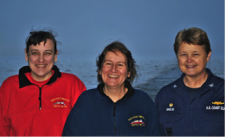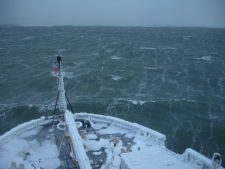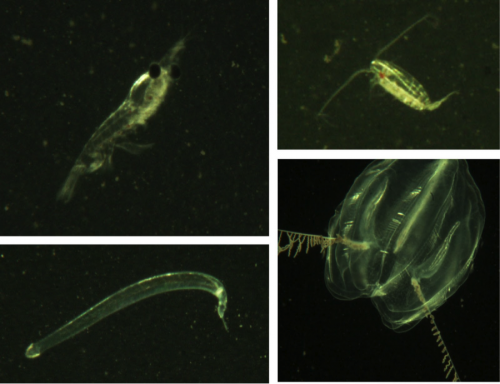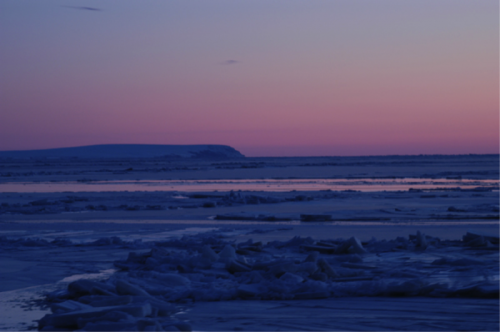In the last months of 2011, scientists and crew aboard the U.S. Coast Guard Cutter Healy conducted the first winter research cruise in the Arctic. The purpose of the forty-day cruise was to collect baseline information on the winter physical and biological characteristics of three important arctic seas: the Bering, the Chukchi, and the Beaufort.

The chief scientist for this cruise, Carin Ashjian of Woods Hole Oceanographic Institution, led the team of 18 scientists in this effort to gain understanding of arctic sea conditions and ecosystems during the winter. Information available before the 2011 cruise was severely limited by difficulties in accessing these regions during winter, the geographically restricted nature of ice camps, and by limitations of the sensor technology deployed over the winter season.
Ashjian particularly aimed to understand the overwintering strategies of one of the dominant copepod genera, Calanus spp., which is critical to ecosystem modeling efforts. Increased knowledge about how this copepod overwinters could improve efforts to model and to predict arctic ecosystems and understand the potential impacts of ongoing climate change.

Copepods are small crustacean plankton (6 to 10 mm or smaller) and are important components of the oceanic food web. They eat phytoplankton (plant plankton), ice algae (algae growing on or under ice), and microzooplankton (zooplankton smaller than copepods). In turn they are a crucial link in the arctic food chain as a food source for larger crustaceans, jellyfish, fish, sea birds, and marine mammals such as the bowhead whale. In terms of overall biomass, species of the genus Calanus are one of the more important types of copepod.
Calanus spp. follow a life cycle in which they spend the productive summer months near the surface of the ocean, feeding on phytoplankton and microzooplankton, and then migrate to deeper water (~100 to 200 m) to overwinter in a type of hibernation called diapause. It is well understood that Calanus spp. found in other parts of the world ocean, such as the northwest Atlantic, can only diapause in deep water; they are not found on the shallow continental shelves in winter. According to what was known about their life history, the Bering and Chukchi shelves are too shallow for Calanus spp. to diapause. It was also thought that during the dark arctic winter season, with the resulting scarcity of ocean plant life, copepods would be semidormant.
During the 2011 cruise, scientists conducted sampling to describe the seasonal hydrography, circulation, and aspects of the planktonic and chemical environments. Specific sampling included physical (e.g., hydrography and circulation), chemical (e.g., nutrients and organic matter), and biological (e.g., zooplankton, microzooplankton, chlorophyll, and bacteria). The main objective was to identify the overwintering habitat of Calanus spp., determine the condition and activity of Calanus spp. and euphausiids, and describe the interconnectedness between species and populations of Calanus and euphausiids in these regions. The team also sought to identify the transformations of Pacific water on the Chukchi Shelf, describe the off-shelf flow of Pacific water into the Arctic Ocean and the circulation and hydrography of Barrow Canyon, and quantify the course- and fine-scale vertical distributions of plankton and particles in relation to the vertical structure of the water column.

Preliminary Findings
The team found a surprisingly active ecosystem despite the low light conditions of the arctic winter season. The Calanus copepods and euphausiids were not dormant but rather were active and were feeding on the very low concentrations of chlorophyll present, suggesting that an active food web was present in this late fall to early winter time frame and that the Calanus copepods may have been continuing to grow and develop through this period. Sea ice and winter water were forming during the cruise. Multiple water mass types were observed with cross- and along-shelf distributions that were sensitive to local wind forcing. For example, populations of Calanus glacialis/marshallae observed in Barrow Canyon, where Atlantic water from the Canada basin was observed, had greater proportions of a younger life stage (i.e., copepodid stage 4) than did populations elsewhere, suggesting a mixing of Arctic basin and shelf populations. Additional analysis is presently being done on bacterial activity and production, primary production, phytoplankton activity and taxonomic composition, zooplankton genetics, RNA/DNA (a measure of metabolic activity), and carbon and nitrogen content. Ultimately, these results will provide key data on ecosystem functioning during the late fall and early winter, which can be used in modeling to better constrain the timing and magnitude of carbon fluxes, the life histories of the important plankton types, and the ecosystem structure before the beginning of primary production in the spring.

For further information about the cruise, see: http://arctic-winter-cruise.blogspot.com/ or contact Carin Ashjian (cashjian [at] whoi.edu).
